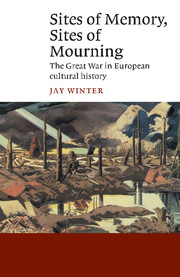Book contents
- Frontmatter
- Contents
- List of illustrations
- Acknowledgements
- List of abbreviations
- Introduction
- I Catastrophe and consolation
- 1 Homecomings: the return of the dead
- 2 Communities in mourning
- 3 Spiritualism and the ‘Lost Generation’
- 4 War memorials and the mourning process
- II Cultural codes and languages of mourning
- Notes
- Bibliography
- Index
1 - Homecomings: the return of the dead
- Frontmatter
- Contents
- List of illustrations
- Acknowledgements
- List of abbreviations
- Introduction
- I Catastrophe and consolation
- 1 Homecomings: the return of the dead
- 2 Communities in mourning
- 3 Spiritualism and the ‘Lost Generation’
- 4 War memorials and the mourning process
- II Cultural codes and languages of mourning
- Notes
- Bibliography
- Index
Summary
The army of the dead
Let us begin with one of the most powerful and haunting visions of the Great War. It is the final sequence of Abel Gance's film J'accuse, made in 1918–19. The hero, Jean Diaz, a wounded soldier-poet, begins to lose his mind. He escapes from hospital, and reaches his village. There he summons the villagers and tells them of a dream. The dream as we see it starts in a battlefield graveyard with wooden crosses all askew. A huge black cloud rises behind it and, magically, ghostlike figures emerge from the ground. They are wrapped in tattered bandages, some limping, some blind walking with upraised arms, some stumbling like Frankenstein's monster. They leave the battlefield and walk down the rural lanes of France to their villages. Their aim is to see if their sacrifices had been in vain. What they find is the pettiness of civilian life, the advantage being taken of soldiers' businesses, the infidelity of their wives. The sight of the fallen so terrifies the townspeople that they immediately mend their ways, and the dead return to their graves, their mission fulfilled. After recounting this dream, the poet, now totally mad, accuses the sun above of standing idly by and watching the war go on. Then he dies.
- Type
- Chapter
- Information
- Sites of Memory, Sites of MourningThe Great War in European Cultural History, pp. 15 - 28Publisher: Cambridge University PressPrint publication year: 1998

